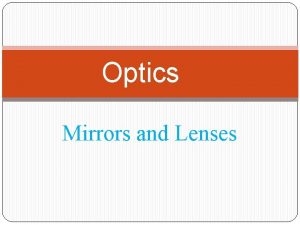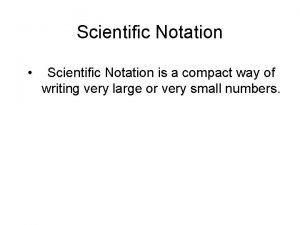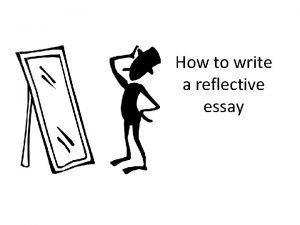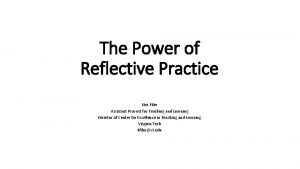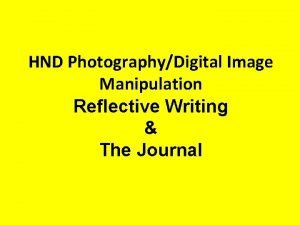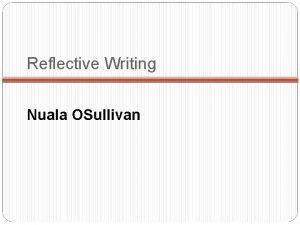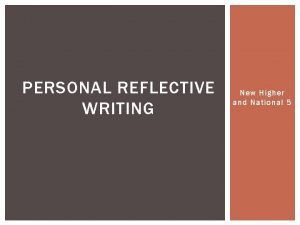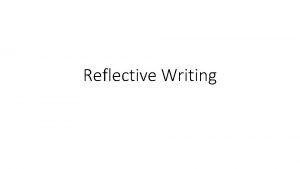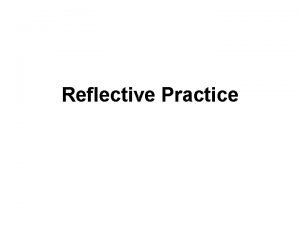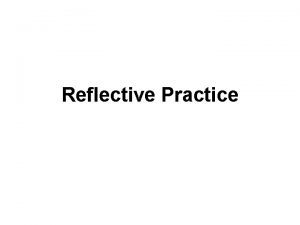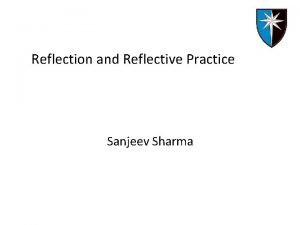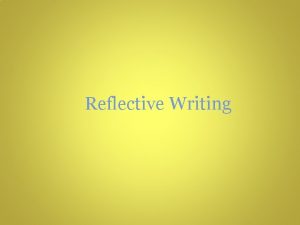Reflective Writing Reflection is a way of learning













- Slides: 13

Reflective Writing Reflection is a way of learning about yourself, your practice and the decisions you make.

Why Reflect? § To provide insight and understanding into your learning, practice and decisions. § To challenge knowledge and practices. § To learn from positive outcomes as much as mistakes. § To ensure care remains patient centred and based on patient experience. “We reflect in order to learn something or we learn as a result of reflecting. ” (Moon, 2004)

How to Reflect § It should be based on your scope of practice. § For revalidation purposes it needs to link to your code of practice. § Reflections do not need to be academic. § Models are available if you prefer to use one. § Make sure you draw out the learning.

Reflections can be based on: § Everyday events / routine activities § Positive or adverse experiences § Incidents § Conferences / training / courses § Professional reading § Feedback (WOW, FFT, audits, complaints, appraisal, performance reports, investigations, etc. )

Make time for reflection § Spend time reflecting before you begin writing. § You don’t need to follow a structure when first reflecting, but some people find it useful when writing. § Reflecting with a trusted colleague can be helpful. § Be open, honest and willing to analyse.

Components of reflective writing You don’t need to follow a framework, but it can help you make sense of your thoughts. Finding your own style and a structure that suits you is important. One way of doing this is by splitting it into 3 key components : 1. 2. 3. Description Reflective questions Outcomes

Components of reflective writing 1: Description The description is a short account of the situation on which you are reflecting, i. e. who, what, where? Top tips: § § Keep it short and to the point Ensure you anonymise any identifiable information e. g. patient details, staff names

Components of reflective writing 2: Reflective questions Use the answers in your writing. § How did I feel and why? § What were my thoughts? § What were the positives and negatives? § What worked well and why? § What could I or others have done differently?

Components of reflective writing 3: Outcomes Think about these questions: § What will you do to take this forward? § What have you learnt about yourself from the process? § What would you do differently next time? § How will you put learning into practice?

Examples of frameworks for reflection: §Atkins & Murphy (1994) §Driscoll (2000) §Gibbs’ reflective cycle (1988) §Johns’ model (2007) §The SRLA Tool (2015) – useful for reflecting on professional reading

Gibbs’ Reflective Cycle (1998) Action Plan Description Conclusion Feelings Analysis Evaluation

Next steps… Reflection identifies improvements we can make to our practice, based on what we have learnt. § So allocate some time and give it a go! § For more information on reflective writing visit Knowlege. Net: http: //www. knowledgenet. ashfordstpeters. nhs. uk/knet. Speci alties. php# § For more information on revalidation visit Trustnet: http: //trustnet/departments/humanresources/nmcrevalidation. html

References § Atkins, S. and Murphy, K. (1994) Reflective Practice. Nursing Standard, 8(39), pp. 49 -56. § Collins, G. and Brown, J. (2015) Searching, Reviewing, Linking, and Action - article reflective tool (SRLA). Derby: University of Derby. § Driscoll, J. (2000) Practising Clinical Supervision. London: Balliere Tindall. § Gibbs , G. (1988) Learning by doing. A guide to teaching and learning methods. Oxford: Oxford Brookes University. § Johns, C. (1995) Framing learning through reflection within Carper’s fundamental ways of knowing in nursing. Journal of Advanced Nursing, 22(2), pp. 226 -234. § Moon, J. (2004) A handbook of reflective and experiential learning. London: Routledge. Falmer.
 Meniscus lens ray diagram
Meniscus lens ray diagram Scientific notation standard form
Scientific notation standard form Essay writing learning outcomes
Essay writing learning outcomes Reflective learning example
Reflective learning example Atkins and murphy reflective model
Atkins and murphy reflective model Uwe reflective writing
Uwe reflective writing Diep reflection
Diep reflection Diep reflection
Diep reflection Reflective writing images
Reflective writing images Reflective writing vocabulary
Reflective writing vocabulary Jenny moon reflective model
Jenny moon reflective model Define reflective writing
Define reflective writing Personal essay examples nat 5
Personal essay examples nat 5 Expressive and reflective writing
Expressive and reflective writing
